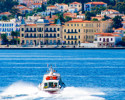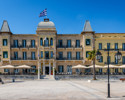There are many things that make stylish Spetses special, but two are extraordinary. Firstly, private cars are banned from the island with just eight taxis operating from the central port and most locals travelling by motorbike. You will also see good vehicles for commercial use only. Second, planning restrictions prevent high-rise buildings and “modern” designs. So, this traditional little island, which has a history that stretches back 10,000 years, has been able to retain a true sense of old Greece.
One holiday, more islands Spetses Island Hopping
Destination Profile
There is only one town. It’s white houses with red-tiled roofs stretch up the hill behind Dapia the “modern” port where ferries dock and horse-drawn taxi carriages wait on the quayside.
Then there is the picturesque old harbour where luxurious yachts and old wooden caiques bob alongside each other. There is an intriguing mix of old and new in the town too.
Imposing captains’ houses left from the era when Spetses was rich through its shipping trade are mixed with restaurants, bars and clubs busy with visitors from abroad and mainland Greece.
Only one road runs from Spetses Town around this lovely island. It’s about 15 miles long and links the sand and shingle beaches and secluded coves with pine forests, soaring green hills, olive groves, lemon trees and almond orchards.
Three thousand years ago the island was called Pityoussa, which meant “covered in pines”. When the Venetians ruled they called it the “Isola di Spezia” (spice island, hence Spetses) because of the aromatic herbs.
One herb, called throubi, has such a pungent smell it’s jokingly said to make the islanders a little bit crazy. One resident certainly wasn’t crazy. He built the road, had tens of thousands of trees planted to replace those cut down for shipbuilding and imposed a condition that the land would never be built on.
Of course, it has not been possible to make time stand still. There are a handful of conventional taxis, a few lorries and agricultural vehicles and lots of mopeds and scooters. But even at peak times it’s possible to find peace and quiet.
The classic mystery novel The Magus was set on Spetses by author John Fowles, who lived and taught at a school there. He described the island as “effortlessly beautiful”. It still is.
Best Time to Visit Spetses
The locals reckon that Spetses has its own special microclimate because it’s the most southerly of the Argo-Saronic islands. It certainly has some lovely warm weather between May and October and, conveniently, the worst of the rain is in November, December and January.
If you’re a walker who loves spring flowers then April and May are the best months for you. The average temperature should stay below 20 degrees Centigrade, cool enough to explore an island that literally blooms with a mass of beautifully coloured flowers.
It’s also cool enough for the Spetsathlon, when thousands of athletes go to Spetses for a challenging range of swimming, cycling and running events.
June through to early September sees about 300 hours of sunshine and the temperature rises gradually to top 30 degrees. The sea temperature is above 20 degrees making it the perfect time to explore the numerous beaches and coves. July is usually the driest month of the year.
Thousands flock to Spetses in September for the Armata Festival when the island celebrates its victory at sea during the Greek War of Independence. A week of events ends with a mock-Turkish ship being destroyed during a firework display.
The sea holds its heat into October and with the average daily temperature almost as hot as in June this early autumn month is good for swimming or hiking, although the chance of a shower is a little bit greater.
October is the month of the hugely popular Spetses Mini Marathon, three-days of swimming and running events that includes Europe’s biggest open sea race.
Spetses Travel Advice
Car hire: Private cars are banned on Spetses so there are no car hire companies. However, there are numerous business renting motorbikes, quad bikes, scooters and mopeds. They are all permitted vehicles and most islanders seem to have one. Once you get out of busy Spetses Town the one winding asphalt road that circles the island is likely to be lightly used even at peak times. You will need a licence suitable for the type of vehicle you want.
Cycle hire: You don’t need a licence for a bike and cycles of all types suitable for riders of all ages and sizes can be hired either by day or longer. There are lots of points of interest to be discovered only a short bike ride from the main town. It’s possible to cycle the 15-mile road around the coastline in about two hours, although most people take longer because they explore the countryside and coves. Those who don’t fancy pedalling up the hills hire an E-bike and let the electric motor take the strain. You will need to leave a deposit and probably show your passport for ID purposes when you rent a cycle.
Taxis: A few cabs that are permitted on the island can be booked by phone (ask wherever you are staying) or can be found on a taxi rank in the main town. In the summer months horse-drawn carriages are for hire. They also line up in the town and wait on the quayside for the ferries to dock. Several water taxis provide services to the island’s most popular beaches and across the three-mile strait to Kosta on the Peloponnese.
Buses: The island’s two buses provide a regular summer-time service from Spetses Town to some of the beaches. One bus starts at the Ayios Mamas town beach and travels to Avia Paraskevi on the southern side of the island via Ayia Marina, Kouzounos, Xilokersiza and Ayia Anargyri. The other starts at the Poseidonion jetty and goes to Vrelos Beach on the south-west of the island via Kaiki and Ligonerie. The buses run between May and October but are dependent on demand. Times are on boards at the two starting points.
Walking: It’s a popular method of getting around and lots of good hiking trails zigzag over the small island. It’s a good way to explore some of the picturesque and more secluded areas, including remote bays and, for the fittest, the highest hill. That is Profitis Ilias and it’s almost 1,000ft high and promises spectacular views. Some of the trails start in Spetses Town. One follows the twists and turns along the coast from the port in the town to the old harbour and on to a 19th century lighthouse on the tip of a peninsula.
Riding: Get in the saddle to trek into the countryside, and you don’t need to know how to ride. Some of the rides are suitable for complete beginners, others will be an interesting work out for advanced riders. The guides speak English and the horses are trained to trek.
Frequently Asked Questions
Why is an unusual blue and red flag flown on some of the fishing boats and water taxis in Spetses?
It’s a revolution flag. Back in the 19th century, when Greece was fighting for independence against the Ottoman Empire, the ships of Spetses and other Argo-Saronic islands won an important battle against the Turkish Navy. The independence flag is still flown by some vessels. The red signifies blood, the pale blue freedom and it carries the Greek slogan for “freedom or death”.
Are there any banks on Spetses?
Several, and they are all in Spetses Town. There are at least three ATM cash machines, so obtaining cash should not be a problem. Use the ATM locator on your credit card company’s web site to find the locations.
How do you get to Spetses?
By ferry from the historic port of Piraeus in Athens, the busiest and most spectacular port in Greece. It’s a splendid voyage of between two to three three hours through the Saronic Gulf and lovely Argo-Saronic islands such as Aigina, Poros and Hydra. The ferry docks in beautiful Spetses Town where most of the accommodation is located.








Date last updated:



